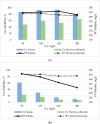Dietary Preference of Newly Weaned Pigs and Nutrient Interactions According to Copper Levels and Sources with Different Solubility Characteristics
- PMID: 32635308
- PMCID: PMC7401595
- DOI: 10.3390/ani10071133
Dietary Preference of Newly Weaned Pigs and Nutrient Interactions According to Copper Levels and Sources with Different Solubility Characteristics
Abstract
Two feeding preference experiments and an in vitro assay were performed to assess the weaned pig preference for Cu doses and sources based on their sensorial perception and on the likely post-ingestive effects of Cu. At day 7 post-weaning, a total of 828 pigs were distributed into two different experiments. In Exp.1 (dose preference) a diet with a nutritional Cu level (15 mg/kg) of Cu sulfate (SF) was pair offered with higher Cu levels (150 mg/kg) of either SF or hydroxychloride (HCl). In Exp.2 (source preference), a diet supplemented with Cu-SF at 150 mg/kg was compared to a Cu-HCl (150 mg/kg) diet. At the short-term (day 7-9) and for the entire experimental week (day 7-14), pigs preferred diets with a high Cu level than with Cu at a nutritional dose (p < 0.05). Likewise, pigs preferred diets supplemented with a Cu-HCl source compared to diets with Cu-SF (p < 0.05). In vitro assay results showed a greater solubility and interaction of Cu-SF with phytic acid compared to Cu-HCl. In conclusion, pigs chose diets with higher levels of Cu probably to re-establish homeostasis after weaning. Pigs preferred diets with Cu-HCl compared to Cu-SF probably due to their solubilities and chemical differences.
Keywords: copper; feed preference; levels; post-ingestive effect; solubility; sources.
Conflict of interest statement
The authors declare no conflict of interest.
Figures



References
-
- Forbes J.M. In: Voluntary Food Intake and Diet Selection in Farm Animals. 2nd ed. Forbes J.M., editor. CABI International; Wallingford, UK: 2007.
-
- Black J.L., Williams B.A., Gidley M. Metabolic regulation of feed intake in monogastric mammals. In: Torrallardona D., Roura E., editors. Voluntary Feed Intake in Pigs. Wageningen Academic Publishers; Wageningen, The Netherlands: 2009.
LinkOut - more resources
Full Text Sources

